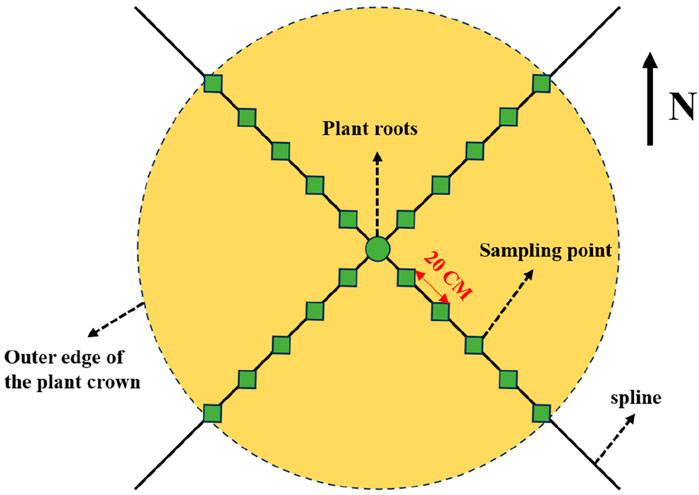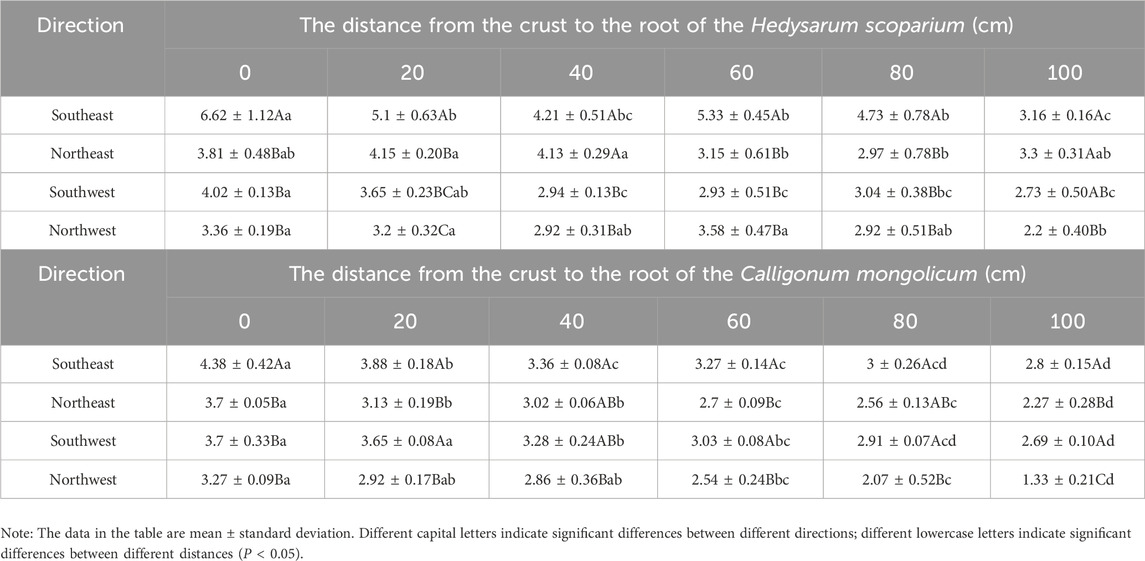- 1College of Desert Control Science and Engineering, Inner Mongolia Agricultural University, Hohhot, China
- 2Inner Mongolia Hangjin Desert Ecological Position Research Station, Ordos, China
In order to explore the effects of two plants on the spatial distribution and nutrient distribution of crusts in different directions and distances after 30 years of aerial seeding, as well as the relationship between crust thickness and nutrient content, this paper takes the aerial seeding afforestation area in the northeastern margin of Tengger Desert as the research area, and the crusts under the plants of Hedysarum scoparium and Calligonum mongolicum as the research objects. The distribution of crust thickness and nutrients was analyzed, and the relationship between them was constructed. The thickness of the crust of H. scoparium and C. mongolicum was the largest in the southeast direction and the smallest in the northwest direction. With increasing distance from the plant, it shows a significant decreasing trend. The crust thickness of H. scoparium was higher than that of C. mongolicum. The nutrient indexes in the southeast direction of the crust of H. scoparium and C. mongolicum were significantly higher than those in the northwest direction; With the increase of the distance from the root of the plant, the nutrient content showed a significant decreasing trend. The contents of organic matter and available nitrogen in the crust of C. mongolicum were higher than those of H. scoparium, and the contents of available potassium and available phosphorus were lower than those of H. scoparium. The trend of nutrient enrichment rate of the crusts of the two plants was consistent with the trend of nutrient distribution. There was a significant positive correlation between the crust thickness and nutrients in the four directions under C. mongolicum. There was a significant positive correlation between the crust thickness and nutrients in the southwest direction under H. scoparium. The changes of available nitrogen, available phosphorus, available potassium and organic matter content in the crust under H. scoparium can explain 52.5% of the change of its thickness. The changes of available nitrogen, available phosphorus, available potassium and organic matter content in the crust under C. mongolicum can explain 78.5% of the change of its thickness. After 30 years of aerial seeding in Tengger Desert, the thickness and nutrients of the crust in the southeast direction of H. scoparium and C. mongolicum were significantly higher than those in the northwest direction and showed a decreasing trend with the increase of distance from the root of the plant. There was a positive correlation between crust nutrient and thickness.
1 Introduction
The Tengger Desert is located in the arid desert area. It is drought, less rain, windy and sandy. It is one of the most serious desertification areas in China (MC Fernandes et al., 2022). After many years of aerial seeding afforestation, the ecological environment has been greatly improved, and a large area of crust is distributed in the aerial seeding area (Antoninka et al., 2020). Crust is a complex biological soil layer formed by the combination of mosses, algae, fungi and bacteria, non-vascular plant components and soil (Caster et al., 2021). The development stage of crust mainly includes four stages: microbial crust, algal crust, lichen crust and moss crust (Gao et al., 2020; Román et al., 2021; Finger-Higgens et al., 2022). There are great differences in the physical and chemical properties of crusts at different stages and types, and the effects on soil are also different (Novakovskaya et al., 2022; Reeve et al., 2023).
In recent years, studies have shown that the crust, as an important basis for vegetation succession in ecologically fragile areas, plays an important role in preventing soil erosion and regulating hydrological processes (De Lima et al., 2021; Nelson and Garcia-Pichel, 2021; Chilton et al., 2022). Its existence significantly increases the accumulation of organic carbon in soil, improves soil physical and chemical properties, improves soil stability (Miralles et al., 2020; Rossi et al., 2022), and then reduces wind erosion and water erosion in sandy soil (Rodríguez-Caballero et al., 2018a). Research finding, the species and distribution of shrubs will affect the growth and distribution of crusts to a certain extent (Kidron, 2019; Soliveres and Eldridge, 2020). The construction of artificial forests is conducive to the formation and development of crusts in shifting sandy land and the improvement of soil properties under the crusts. With the growth and development of the plantation, the coverage, thickness, hardness, clay and silt, organic matter, and nutrient content of the crust increased significantly. On the one hand, the mechanism of artificial vegetation construction on the formation and development of crust and the process of soil formation in the lower layer is due to the effect of artificial vegetation on reducing wind and dust, maintaining sand surface stability and increasing the content of clay and silt on the surface. On the other hand, the production and deposition of large amounts of litter, as well as the improvement of local hydrothermal environment, increased the organic matter and nutrient content of crusts and topsoil and promoted the invasion of microorganisms and vascular plants (Aranibar et al., 2022). At the same time, crusts have a strong enrichment effect on soil nutrients and with the increase of soil depth showed a decreasing trend (Bowker et al., 2020; Gallas and Pavao-Zuckerman, 2022; Li et al., 2022). At present, the research on different types of crusts and their effects on the lower soil is relatively comprehensive (Mugnai et al., 2020), but there are few studies on the spatial distribution characteristics of crusts in different directions and distances from the roots of plants, the relationship between crust thickness and nutrients is not yet clear. Therefore, this paper proposes a hypothesis that crust nutrient changes will affect crust thickness.
Based on this, this paper takes the crusts of Hedysarum scoparium and Calligonum mongolicum in the aerial seeding afforestation area in the northeastern margin of Tengger Desert in Alxa Left Banner as the research object, analyzes its spatial distribution characteristics, and the relationship between crust thickness and nutrients was explored, aiming to study the improvement effect of plants on crusts, so as to provide theoretical basis and scientific basis for the prevention and control of desert wind erosion in arid area.
2 Materials and methods
2.1 Study area
The research area is located in the 1992 aerial seeding afforestation area (referred to as the 92 sowing area) on the northeastern margin of the Tengger Desert. The administrative division is subordinate to the Alashan Left Banner of Alashan League, Inner Mongolia Autonomous Region (39° 11′−39° 18′N, 104° 53′−104° 57′E). It is a typical temperate continental dry climate with a prevailing northwest wind. It is characterized by drought, large temperature difference, large evaporation, strong sunshine and scarce rainfall. The average annual rainfall is between 80 and 200 mm, and the average annual evaporation is between 2,900 and 3,300 mm. The soil type is mainly sandy soil, and the natural vegetation is mainly sandy plants, They are mainly Sarcozygium xanthoxylon, Oxytropis aciphylla, Nitraria tangutorum, etc. The aerial vegetation is H. scoparium, C. mongolicum, Artemisia sphaerocephala (Pombubpa et al., 2020). A large area of crust is distributed in the study area, with a coverage of more than 60%.
2.2 Experimental design and sample collection
The experiment was carried out in September 2023, and the H. scoparium and C. mongolicum with good growth and similar plant height and crown were selected in the 92 sowing area. In the plot with H. scoparium and C. mongolicum as the dominant species, three 20 m × 20 m quadrats were evenly set along the diagonal of the main wind direction (northwest-southeast) in the study area. One plant with good growth and crust growth was selected from each quadrat, 3 plants for each plant, a total of 6 plants. In order to reduce the interaction between shrubs and shrubs, each plant maintains a distance of more than 10 m from adjacent plants in different directions. There was no rainfall in the week before sampling. As shown in the Figure 1, Taking the selected plant root as the origin, parallel and vertical to the local main wind direction (northwest), along the four directions of southeast, northeast, southwest and northwest respectively, a crust with a size of 5 cm × 5 cm was taken every 20 cm as a sample, and stopped at 1 m from the root of the plant (0, 20, 40, 60, 80, 100 cm from the root of the plant). In each plot, a piece of crust (5 cm × 5 cm) without plants around was selected as the crust sample control (CK), and a total of 6 × 4 × 6 + 2 = 146 soil samples were collected. The thickness of the crust was measured (the average value was obtained by repeated measurement for 3 times), the soil samples were loaded into plastic bags and brought back to the laboratory. After drying in the shade, they were sieved and the nutrient content was determined.
2.3 Sample processing and data analysis
The crust thickness was measured three times with a vernier caliper to obtain the average value. Soil available potassium was detected by flame spectrophotometry; soil available phosphorus was detected by molybdenum antimony colorimetric method. Soil available nitrogen was detected by alkaline hydrolysis diffusion method. Soil organic matter was detected by potassium dichromate method-external heating method, The detection method mainly refers to soil agrochemical analysis.
Enrichment rate (E) is the enrichment degree of soil nutrients. In this study, the soil nutrient enrichment rate under vegetation was calculated by the following method: E = x/x0, where x represents the soil nutrient content at different distances from the root of the plant, and x0 represents the control. If E > 1, it indicates that the soil nutrients are enriched at the sampling site, on the contrary, they are enriched at the blank control site. The larger the E value is, the stronger the nutrient enrichment effect is.
Excel 2022 was used for preliminary data statistics and processing. IBM SPSS statistics 25 software was used for one-way analysis of variance to analyze the differences in crust thickness, soil nutrient content in four directions at different distances from the roots of H. scoparium and C. mongolicum, as well as the differences in soil nutrient enrichment rates of different plants. Origin 2019 was used for plotting.
3 Results and analysis
3.1 Spatial distribution characteristics of crusts under two aerial seeding plants
It can be seen from Table 1 that the crust thickness of the two plants showed significant differences in different horizontal distances and different directions (P < 0.05). The crust thickness of H. scoparium was about 2.2–6.62 mm, and the crust thickness of C. mongolicum was about 1.33–4.38 mm. By comparing the crust thickness in different directions and different distances under the plants, it was found that the crust thickness at 0 cm of the roots of the two plants in the southeast direction was significantly higher than other distances in the southeast direction, and with the increase of distance, it showed a significant decrease trend. The crust thickness at 100 cm from the root of C. mongolicum in the northwest direction was significantly lower than other distances in the northwest direction. The crust thickness at 0, 20, 60 and 80 cm from the root of the H. scoparium in the southeast direction was significantly higher than that in the other three directions at the same distance. The crust thickness at 0 cm from the root of C. mongolicum in the southeast direction was significantly higher than that in the other three directions at the same distance, but the crust thickness at any distance under the two plants in the southeast direction was significantly higher than that in the northwest direction. On the whole, in the same direction and the same distance, the crust thickness of H. scoparium was higher than that of C. mongolicum.
In terms of direction, the crust thickness of H. scoparium and C. mongolicum in the southeast direction is the largest, and the crust thickness in the northwest direction is the smallest; from the point of view of distance, the crust thickness at 0 cm from the root of the plant is the thickest, and the crust thickness at 100 cm is the smallest. In general, the crust thickness at 0 cm in the southeast direction is the largest, and the crust thickness at 100 cm in the northwest direction is the smallest.
3.2 Nutrient distribution characteristics of crust under two kinds of aerial seeding plants
The nutrient distribution characteristics of the crusts of the H. scoparium were shown in Figure 2, and the nutrients showed significant differences in different horizontal distances and different directions (P < 0.05). The organic matter content of the crust under the H. scoparium is about 4.06–14.15 g·kg−1. According to the different horizontal distances from the root in the same direction, the organic matter content of the crust at 0 cm from the root of the H. scoparium in the southeast and southwest directions was significantly higher than that in the other distances in the two directions, and with the increase of the distance, the organic matter content of the crust in the four directions showed a decreasing trend. In the same horizontal distance from the roots in different directions, the organic matter content of crusts under the H. scoparium at any distance under the southeastern direction was significantly higher than that in the northwest direction. The content of available nitrogen in the crust under H. scoparium was about 0.70–21.12 mg·kg−1. At different horizontal distances from the root in the same direction, the available nitrogen content of crust at 0 cm in four directions was significantly higher than that at 100 cm. With the increase of distance, the content of available nitrogen in the four directions decreased as a whole. At the same horizontal distance from the root in different directions, the content of available nitrogen in the crust at 100 cm from the root of H. scoparium in the southeastern direction was significantly higher than that in the other three directions, but the content of available nitrogen in the crust under the H. scoparium at any distance under the southeastern direction was significantly higher than that in the northwest direction.
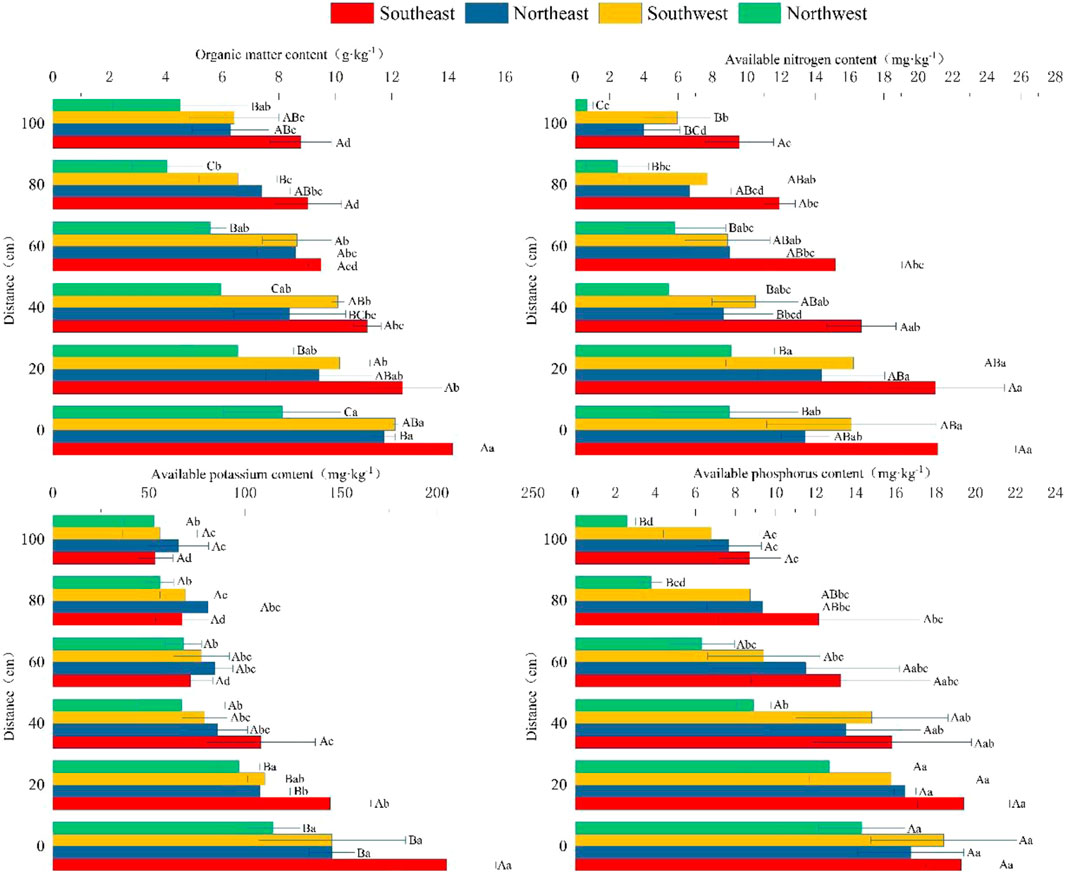
Figure 2. Nutrient distribution law of crust under Hedysarum scoparium. Note: Different capital letters indicate significant differences between different directions; different lowercase letters indicate significant differences between different distances (P < 0.05).
The content of available potassium in the crust under the H. scoparium was about 52.67–205 mg·kg−1. From the perspective of different horizontal distances from the roots in the same direction, the content of available potassium in the crust at 0 cm in the roots of H. scoparium in the southeast and northeast directions was significantly higher than other distances in these two directions, and the content of available potassium in the crust at 0 cm in the four directions was significantly higher than that at 100 cm. With the increase of distance, the content of available potassium in the four directions decreased as a whole. In terms of the same horizontal distance from the roots in different directions, the available potassium content of the crusts at 0 cm and 20 cm from the roots of the southeastern direction was significantly higher than that of the crusts at the same distance from the other three directions. The content of available phosphorus in the crust under H. scoparium was about 2.59–19.41 mg·kg−1. At different horizontal distances from the root in the same direction, the available phosphorus content of crust at 0 cm in four directions was significantly higher than that at 80 cm and 100 cm. With the increase in distance, the available phosphorus content of crusts in four directions showed a decreasing trend as a whole. In the same horizontal distance from the roots in different directions, the available phosphorus content of the crusts at 80 cm and 100 cm from the roots in the southeastern direction was significantly higher than that of the crusts at the same distance in the northwest direction.
The distribution characteristics of nutrients in the crust of C. mongolicum were shown in Figure 3. There were significant differences in nutrients at different horizontal distances and different directions (P < 0.05). The content of organic matter in the crust of C. mongolicum was about 7.73–15.33 g·kg−1. According to the different horizontal distances from the root in the same direction, the organic matter content of the crust at 0 cm from the root of C. mongolicum in the four directions was significantly higher than that at 40, 60, 80 and 100 cm in the corresponding direction. With the increase of distance, the organic matter content of the crust in the four directions showed a decreasing trend. In the same horizontal distance from the roots in different directions, the organic matter content of crusts at 20, 40, 60, 80 and 100 cm from the roots of C. mongolicum in the southeast, northeast and southwest directions was significantly higher than that in the northwest direction at the same distance. The content of available nitrogen in the crust of C. mongolicum was about 1.52–38.03 mg·kg−1. At different horizontal distances from the root in the same direction, the available nitrogen content of 0 cm and 20 cm in the four directions was significantly higher than that of 80 cm and 100 cm. With the increase of distance, the available nitrogen content of crust in four directions showed a decreasing trend as a whole. At the same horizontal distance from the root in different directions, the available nitrogen content of crusts at 0, 40 and 60 cm from the root of C. mongolicum in the southeast direction was significantly higher than that in the other three directions at the same distance, and the available nitrogen content of crusts at any distance in the southeast direction was significantly higher than that in the northwest direction.
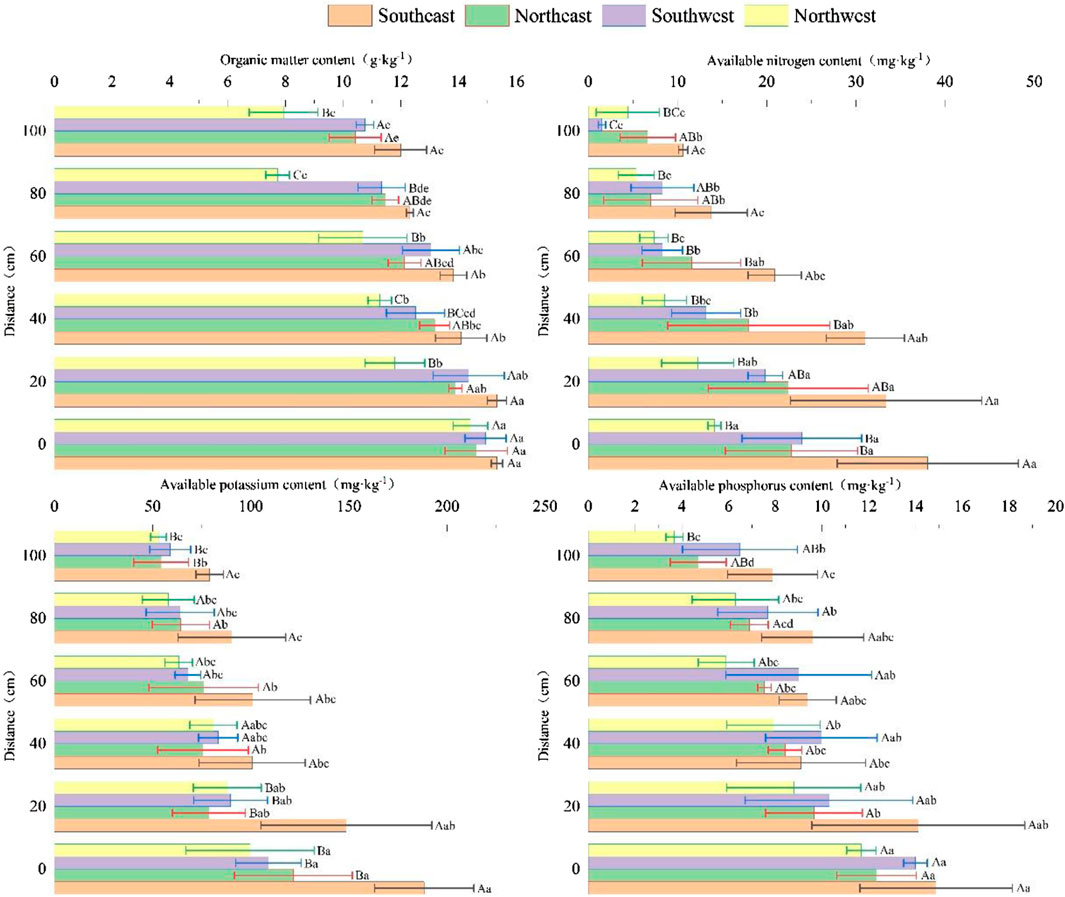
Figure 3. Nutrient distribution law of crust under Calligonum mongolicum. Note: Different capital letters indicate significant differences between different directions; different lowercase letters indicate significant differences between different distances (P < 0.05).
The content of available potassium in the crust of C. mongolicum was about 53–188.33 mg·kg−1. At different horizontal distances from the root in the same direction, the content of available potassium in the crust at 0 cm in the four directions was significantly higher than that at 100 cm. With the increase of distance, the content of available potassium in the four directions decreased as a whole. According to the same horizontal distance from the root in different directions, the content of available potassium in the crust at 0, 20 and 100 cm from the root of C. mongolicum in the southeast direction was significantly higher than that in the other three directions at the same distance from the root of C. mongolicum. The content of available phosphorus in the crust of C. mongolicum was about 3.68–14.88 mg·kg−1. According to the different horizontal distances from the root in the same direction, the content of available phosphorus in the crust at 0 cm from the root of C. mongolicum in the northeast direction was significantly higher than that in the other distances in this direction, and the content of available phosphorus in the crust at 0 cm in the four directions was significantly higher than that at 100 cm. With the increase of distance, the content of available phosphorus in the four directions decreased as a whole. In terms of the same horizontal distance from the roots in different directions, the available phosphorus content in the crust at 100 cm from the roots of C. mongolicum in the southeast direction was significantly higher than that in the northwest direction at 100 cm.
3.3 Characteristics of nutrient enrichment rate of crusts under two kinds of aerial seeding plants
The nutrient enrichment degree and difference of H. scoparium crusts in different spaces are shown in Figure 4. The nutrient enrichment rate of H. scoparium crusts showed significant differences in different horizontal distances and different directions (P < 0.05). In terms of different horizontal distances from the root in the same direction, the enrichment rate of crust organic matter at 0 cm from the root of H. scoparium in the southeast and southwest directions was significantly higher than that in the other distances in the two directions. The enrichment rate of crust organic matter and available nitrogen at 0 cm in the four directions were significantly higher than those at 100 cm. The enrichment rate of available potassium in the crust at 0 cm in the roots of H. scoparium in the southeast and northeast directions was significantly higher than that in other distances in these two directions, and the enrichment rate of available potassium in the crust at 0 cm in the four directions was significantly higher than that at 100 cm. In the four directions, there was no significant difference in the enrichment rate of available phosphorus in 0 cm and 20 cm from the root of H. scoparium, but the enrichment rate of available phosphorus in 0 cm was significantly higher than that in 80 cm and 100 cm. In general, with the increase of distance, the nutrient enrichment rate of the four directions decreased.
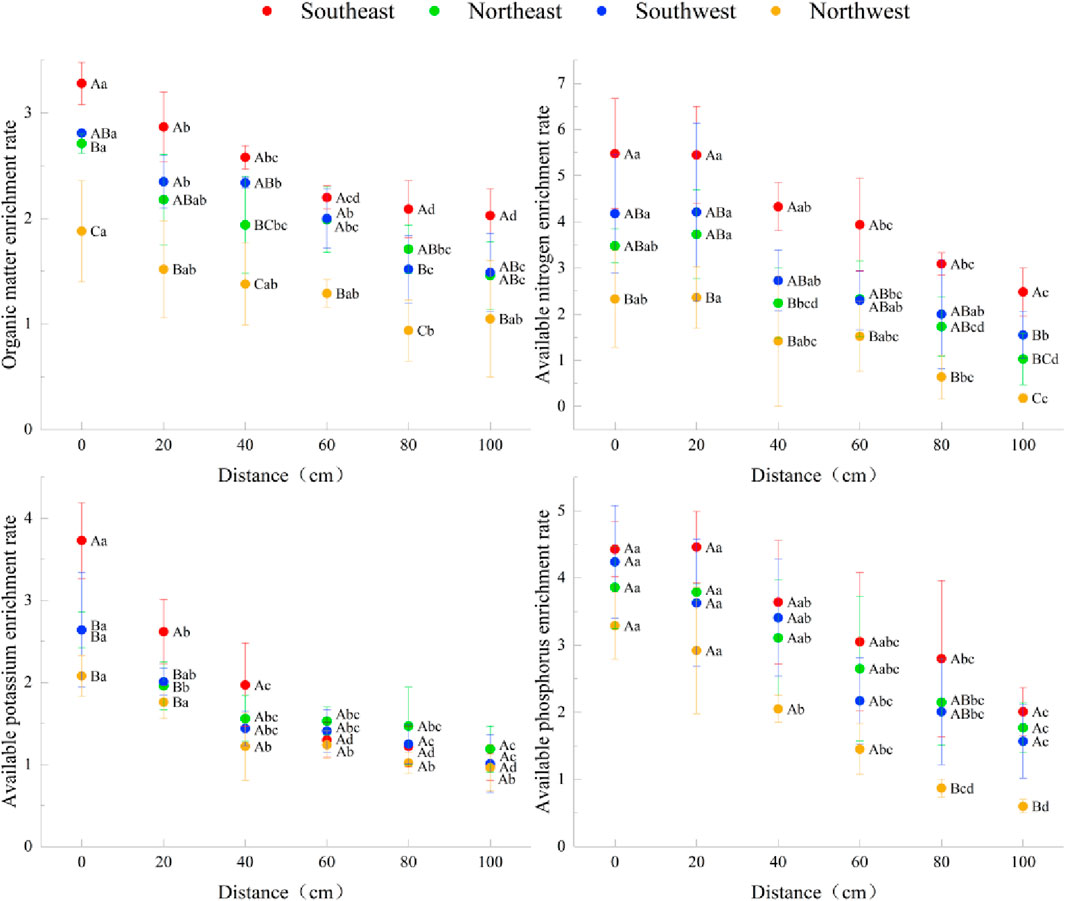
Figure 4. Nutrient enrichment rate of crust under Hedysarum scoparium. Note: Different capital letters indicate significant differences between different directions; different lowercase letters indicate significant differences between different distances (P < 0.05).
From the perspective of the same horizontal distance from the roots in different directions, the organic matter enrichment rate and available nitrogen enrichment rate of crusts at any distance under the southeastern direction were significantly higher than those in the northwest direction, and the available nitrogen enrichment rate of crusts at 100 cm from the roots of the southeastern direction was significantly higher than that at 100 cm in the other three directions. The enrichment rates of organic matter and available nitrogen in the southeastern direction were generally southeast > southwest > northeast > northwest; The enrichment rate of available potassium in the crust at 0 cm and 20 cm from the root of H. scoparium in the southeast direction was significantly higher than that in the other three directions at the same distance. The enrichment rate of available potassium in H. scoparium was southeast > northeast > southwest > northwest; the enrichment rate of available phosphorus in the crust at 80 cm and 100 cm from the root of H. scoparium in the southeast direction was significantly higher than that in the crust at the same distance in the northwest direction. The enrichment rate of available phosphorus in H. scoparium was southeast > northeast, southwest > northwest, and there was no significant difference in the enrichment rate of available phosphorus between northeast and southwest.
The degree and difference of nutrient enrichment of C. mongolicum in different spaces. As shown in Figure 5, the nutrient enrichment rate of C. mongolicum in different horizontal distances and directions showed significant differences (P < 0.05). According to the different horizontal distances from the root in the same direction, the organic matter enrichment rate of crusts at 0 cm from the root of C. mongolicum in the four directions was significantly higher than that of crusts at 40, 60, 80 and 100 cm in the corresponding directions. The available nitrogen enrichment rates of crusts at 0 cm and 20 cm in four directions were significantly higher than those at 80 cm and 100 cm. The enrichment rate of available potassium and available phosphorus in 0 cm from the root of C. mongolicum in four directions were significantly higher than those in 100 cm, and the enrichment rate of available phosphorus in 0 cm from the root of C. mongolicum in the northeast direction was significantly higher than that in other distances in this direction. Overall, with the increase of distance, the nutrient enrichment rate of C. mongolicum crusts in four directions showed a decreasing trend.
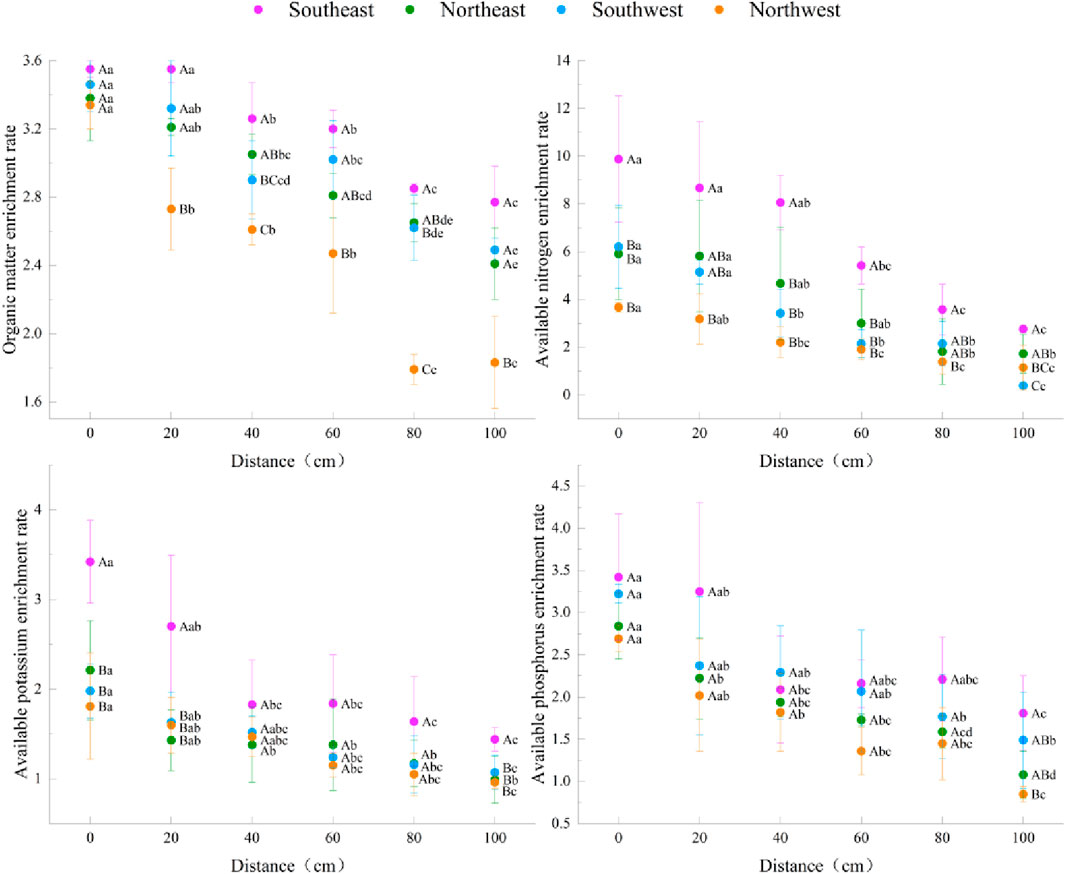
Figure 5. Nutrient enrichment rate of crust under Calligonum mongolicum. Note: Different capital letters indicate significant differences between different directions; different lowercase letters indicate significant differences between different distances (P < 0.05).
At the same horizontal distance from the root in different directions, the enrichment rate of organic matter in the southeast, northeast and southwest directions was significantly higher than that in the northwest direction. The organic matter enrichment rate of C. mongolicum was southeast > southwest > northeast > northwest; The enrichment rate of available nitrogen in 0, 40 and 60 cm from the root of C. mongolicum in the southeast direction was significantly higher than that in the other three directions, and the enrichment rate of available nitrogen in any distance in the southeast direction was significantly higher than that in the northwest direction. The enrichment rate of available nitrogen in C. mongolicum was southeast > northwest; The enrichment rate of available potassium in the crust at 0, 20 and 100 cm from the root of C. mongolicum in the southeast direction was significantly higher than that in the crust at the same distance in the other three directions. The enrichment rate of available potassium in C. mongolicum was southeast > southwest, northeast > northwest. The enrichment rate of available phosphorus in the crust at 100 cm from the root of C. mongolicum in the southeast direction was significantly higher than that in the northwest direction at 100 cm. The enrichment rate of available phosphorus in C. mongolicum was southeast > southwest > northeast > northwest.
3.4 Correlation between spatial distribution characteristics of crust and nutrient distribution characteristics of two aerial seeding plants
The correlation between the thickness of the crust and the nutrients of the H. scoparium is shown in Figure 6. The thickness of the crust of the H. scoparium in the southeast direction is not related to the nutrients. The organic matter and available nitrogen, available phosphorus and available potassium are significantly positively correlated (P < 0.01). There was a significant positive correlation between available nitrogen and available potassium (P < 0.05), and a significant positive correlation with available phosphorus (P < 0.01). There was a significant positive correlation between available potassium and available phosphorus (P < 0.05). There was no correlation between the crust thickness and nutrients in the northeast direction. There was a significant positive correlation between organic matter and available nitrogen and available phosphorus (P < 0.05), and a highly significant positive correlation with available potassium (P < 0.01). There was a significant positive correlation between available nitrogen and available potassium (P < 0.05), and a highly significant positive correlation with available phosphorus (P < 0.01). There was a significant positive correlation between available potassium and available phosphorus (P < 0.05). The crust thickness of H. scoparium in the southwest direction was significantly positively correlated with available nitrogen and available potassium (P < 0.01), and significantly positively correlated with available phosphorus (P < 0.05). The crust thickness of H. scoparium in the northwest direction was not related to nutrients, and organic matter was significantly positively correlated with available phosphorus and available potassium (P < 0.01), and significantly positively correlated with available nitrogen (P < 0.05). There was a significant positive correlation between available nitrogen and available potassium (P < 0.05), a highly significant positive correlation with available phosphorus (P < 0.01), and a highly significant positive correlation between available potassium and available phosphorus (P < 0.01).
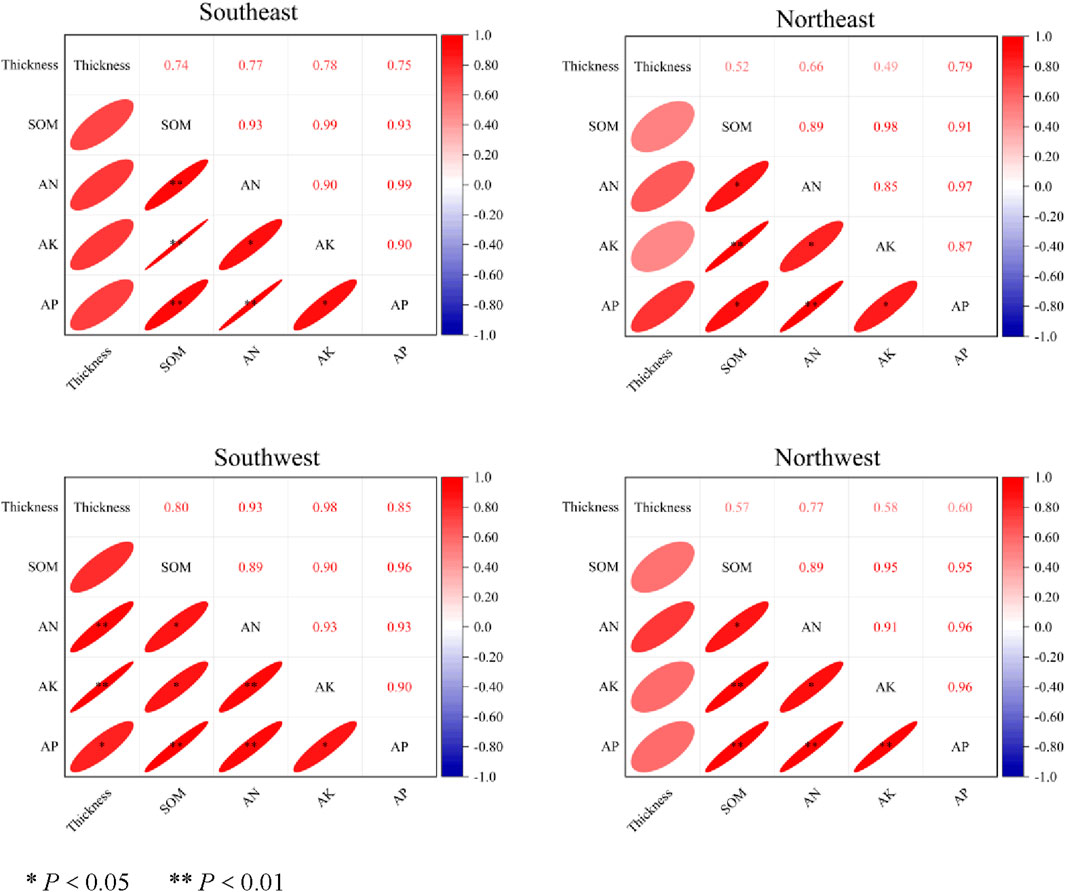
Figure 6. Correlation analysis between the spatial distribution characteristics and nutrient distribution characteristics of crusts under Hedysarum scoparium.
The correlation between the crust thickness and nutrients of C. mongolicum. As shown in Figure 7, the crust thickness of C. mongolicum in the southeast direction was significantly positively correlated with organic matter, available nitrogen, available phosphorus and available potassium (P < 0.01). There was a significant positive correlation between organic matter and available nitrogen (P < 0.01), and a significant positive correlation with available phosphorus and available potassium (P < 0.05). There was a significant positive correlation between available nitrogen and available potassium (P < 0.05), and there was no correlation with available phosphorus. There was a significant positive correlation between available potassium and available phosphorus (P < 0.01). The crust thickness of C. mongolicum in the northeast direction was significantly positively correlated with organic matter, available nitrogen, available phosphorus and available potassium (P < 0.01). The crust thickness of C. mongolicum in the southwest direction was significantly positively correlated with organic matter, available nitrogen and available potassium (P < 0.01), and significantly positively correlated with available phosphorus (P < 0.05). The crust thickness of C. mongolicum in the northwest direction was significantly positively correlated with organic matter, available nitrogen, available phosphorus and available potassium (P < 0.05). Organic matter was significantly positively correlated with available nitrogen and available potassium (P < 0.01), and significantly positively correlated with available phosphorus (P < 0.05). Available nitrogen was significantly positively correlated with available potassium and available phosphorus (P ≤ 0.01).
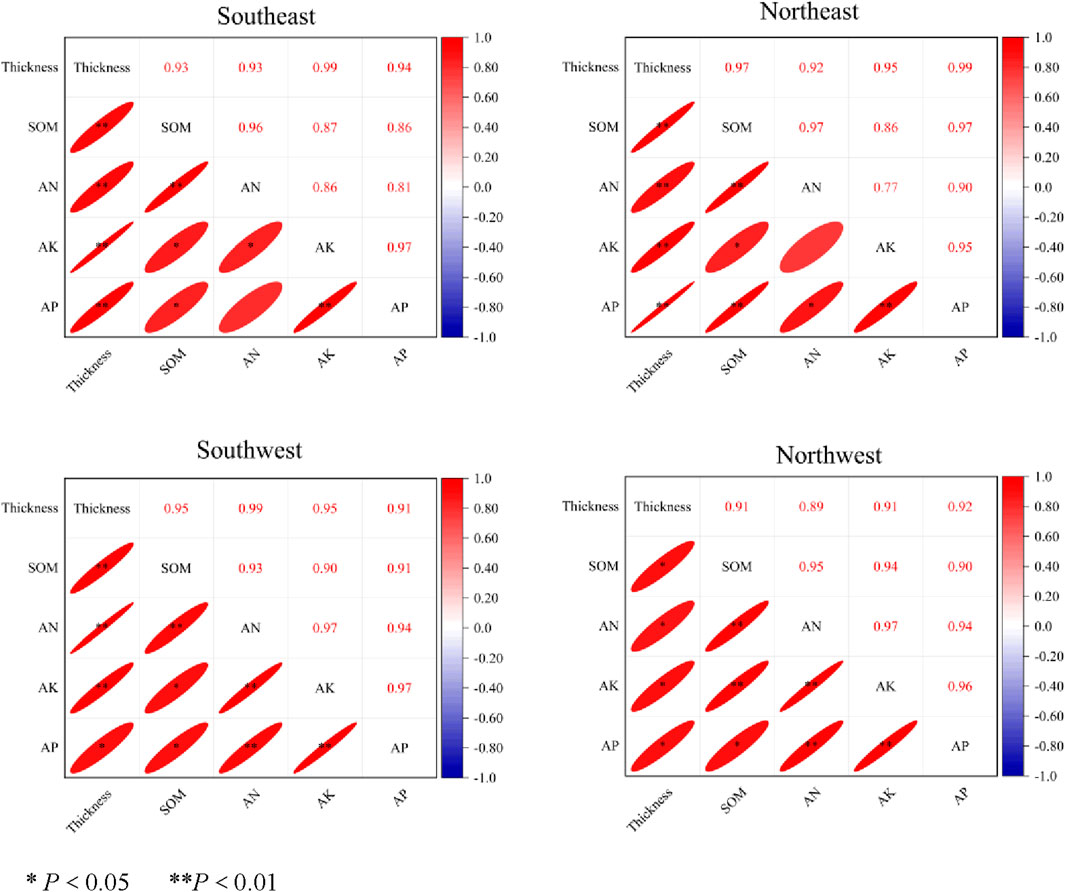
Figure 7. Correlation analysis between the spatial distribution characteristics and nutrient distribution characteristics of crusts under Calligonum mongolicum.
The correlation analysis between crust thickness and nutrients of H. scoparium and C. mongolicum plants is shown in the Table 2. It can be seen from the table that the crust thickness of H. scoparium and C. mongolicum plants was significantly correlated with AN, AP, AK and SOM (P < 0.05). At the same time, VIF <5 between AN, AP, AK and SOM, there is no collinearity problem. Model selected available nitrogen (x1), available phosphorus (x2), available potassium (x3), organic matter (x4) four indicators. Taking the above x1 ∼ x4 as the independent variable and the crust thickness (y) as the dependent variable, the results are shown in the Table 3. The relationship equation between crust nutrient and crust thickness of H. scoparium was y = 0.048x1-0.016x2 + 0.008x3 + 0.125x4 + 1.586, R2 = 0.525. The significance of the equation is: when the other three values of the four variables are fixed at a certain level within the test range, the crust thickness (y) increases by 0.048 for every one increase in available nitrogen (x1); for every one increase in available phosphorus (x2), the crust thickness (y) decreased by 0.016. For every one increase in available potassium (x3), the crust thickness (y) increased by 0.008; for every one increase in organic matter (x4), the crust thickness (y) increases by 0.125. It means that available nitrogen, available phosphorus, available potassium, and organic matter can explain 52.5% of the change in thickness. The relationship equation between crust nutrient and crust thickness of C. mongolicum was established: y = −0.001x1 + 0.001x2 + 0.006x3 + 0.202x4 + 1.586, R2 = 0.785. The significance of the equation is that when the other three values of the four variables are fixed at a certain level within the test range, the crust thickness (y) decreases by 0.001 for every one increase in available nitrogen (x1). For every one increase in available phosphorus (x2), the crust thickness (y) increased by 0.001; for every one increase in available potassium (x3), the crust thickness (y) increased by 0.006; for every one increase in organic matter (x4), the crust thickness (y) increases by 0.202. It means that available nitrogen, available phosphorus, available potassium and organic matter can explain 78.5% of the change in thickness.

Table 2. Correlation analysis of crust thickness and nutrient under two kinds of aerial seeding plants.
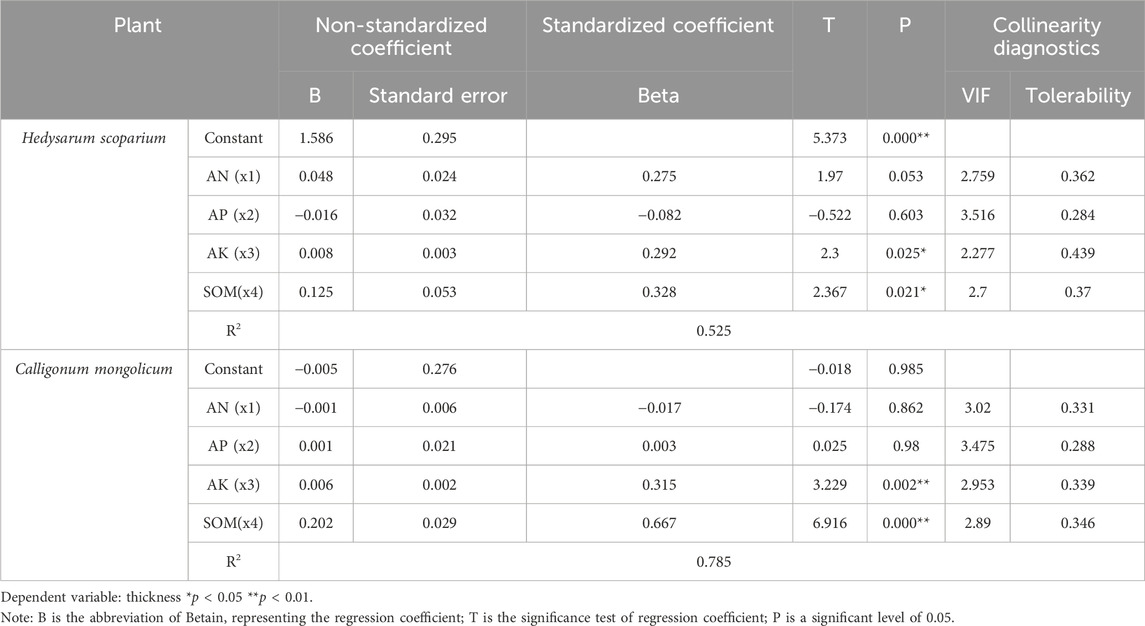
Table 3. Linear regression equation model of crust thickness and nutrients under two kinds of aerial seeding plants.
4 Discussions
4.1 Effects of two aerial seeding plants on the spatial distribution of their lower crusts
Crusts have a great effect on soil and water conservation, windbreak and sand fixation in desert areas. On mobile dunes, it is difficult to form crusts due to poor stability of topsoil and wind erosion without plant shelter (Rodríguez-Caballero et al., 2018b; Pombubpa et al., 2020; Weber et al., 2022), but due to external force intervention, the wind and sand activities are weakened, the topsoil tends to be stable, there are plant shelters and provide nutrition, and crusts will gradually form. After the aerial seeding of plants, with the increase of sand fixation years, the plant lower crust gradually developed from physical crust to lichen crust and then to moss crust and algae crust on the time scale. Under the influence of topography, environment and plant itself, the spatial distribution of plant lower crusts shows a certain regularity. The crust thickness of H. scoparium and C. mongolicum in the southeast direction was significantly higher than that in the other three directions, and the crust thickness in the northwest direction was significantly lower than that in the southeast direction, which was consistent with the previous research results (Kidron et al., 2022). This is due to the prevailing northwest wind in the study area. Under the wind erosion, the fine sand and litter at the windward slope are taken away, and the leeward slope is retained due to the occlusion of plant leaves and branches. Coupled with the accumulation of fine sand and litter around, it promotes the development of crusts and the accumulation of crust nutrients, and also increases the thickness of crusts. The crust on the windward slope develops slowly due to wind erosion and insufficient nutrients, and the crust thickness also decreases. The crusts in the northeast and southwest directions are also affected by the wind, but the degree of influence is less than that of the windward slope, so the crust thickness is between the windward slope and the leeward slope. The crust thickness at 0 cm from the root of H. scoparium and C. mongolicum is the largest in the study area, and the crust thickness decreases with the distance from the root of the plant. The crust thickness at 0 cm is significantly higher than that at 100 cm. The study on the distribution of crust thickness at different distances under the canopy of Artemisia ordosica in Mu Us Sandy Land (Reed et al., 2019) found that the crust thickness at 20 cm from the root of the plant is the highest, which is inconsistent with the results of this study. It may be the reason why the root architecture of different plants is different. The effect of roots on the surface soil near the roots during the growth of H. scoparium and C. mongolicum was greater than that of A. ordosica, so the effect on nutrient accumulation was stronger. It may also be due to the different soil textures of the two places, so that the crust thickness at 0 cm from the root of the plant is the largest in the study area. The thickness of the crust under the H. scoparium is higher than that of the C. mongolicum. This may be because the plant morphology of H. scoparium is larger than that of C. mongolicum, and the branches and leaves of H. scoparium are more lush than those of C. mongolicum. Therefore, the interception effect on fine sand is stronger, and the ability to resist wind erosion is stronger, which is more conducive to the development of crust.
4.2 Effects of two kinds of aerial seeding plants on nutrient distribution and enrichment rate of their lower crusts
The spatial distribution characteristics of soil nutrients can reflect the relationship between soil nutrients and environmental factors. In the vegetation-soil system, the distribution of vegetation is closely related to the spatial distribution of soil nutrients. In this study, the nutrient distribution of crusts under H. scoparium and C. mongolicum showed a certain regularity. The nutrient indexes of crusts in the southeast direction were significantly higher than those in the northwest direction, which was consistent with the results of previous studies (Kidron et al., 2022). This is due to the change of plant morphology caused by the wind direction. Due to the prevailing northwest wind all year round, under the action of long-term external force, the branches of plants in the aerial seeding area extend and grow in the southeast direction, which also makes the litter in the southeast direction far more than that in the northwest direction. The accumulation of litter increases the nutrients of its lower crust, and the clay and silt intercepted by plants are distributed in a diffuse manner along the southeast direction, and finally presents the nutrient distribution characteristics of southeast > northwest. The crust nutrients at different distances in the same direction under the plant also have certain rules. The closer the crust is to the root of the plant, the higher the nutrient content is. This is due to the attenuation of the wind by the branches of the plant, which makes the litter, clay and silt accumulate in the root and increases the nutrient content of the root. The content of organic matter and available nitrogen in the crust of C. mongolicum was higher than that of H. scoparium, and the content of available potassium and available phosphorus was lower than that of H. scoparium. It may be due to the accumulation effect of C. mongolicum on organic matter and available nitrogen is more significant, and the accumulation effect of H. scoparium on available potassium and available phosphorus is more significant. There was no significant difference in the content of available phosphorus in the four directions of crust under the H. scoparium and C. mongolicum, which was consistent with the results of previous studies (Sun et al., 2021). This may be because phosphorus is a sedimentary mineral with low mobility and is less affected by wind direction and plant morphology. The comprehensive analysis shows that the change of nutrients is determined by many factors such as species, spatial location, and the nature of the index itself. There are obvious differences in different nutrient contents of different plant species and spatial locations, indicating that different plants have different adaptability to the soil environment.
Plants have an enrichment effect on soil nutrients. The crust enrichment rate in this study has certain regularity, which is related to different directions and different positions from the root of the plant. The crust enrichment rate of the two plants shows the same trend, that is, the southeast direction is significantly higher than the northwest direction. From the root of the plant to the outside, the crust nutrient enrichment rate shows a decreasing trend. This is consistent with the spatial distribution of nutrients, which once again proves that the accumulation of nutrients in the crust under the plant is closely related to the wind direction, plant morphology, and the accumulation of litter, silt and clay. Crust nutrient enrichment has a good improvement effect on local soil, which can increase soil water content and prevent soil erosion and soil desertification (Sun et al., 2021).
4.3 The relationship between crust spatial distribution and nutrient distribution under two kinds of aerial seeding plants
In the process of crust evolution, the physical and chemical properties of crusts are interdependent with crust types, plant physiological characteristics, soil microorganisms and other factors. The differences in bacterial community structure and plant physiological characteristics may promote the improvement of the physical and chemical properties of crusts, and their correlations are different (Bowker et al., 2018; Muñoz-Martín et al., 2019). In this study, it was found that there was a correlation between the spatial distribution of crusts and nutrient distribution under the two aerial seeding plants in the study area. The crusts distributed in the four directions under C. mongolicum were significantly correlated with nutrients. Among them, there was a highly significant positive correlation in the northeast direction and a significant positive correlation in the northwest direction. The previous study also showed that the change trend of crust thickness of C. mongolicum was consistent with the change trend of nutrients, It can be seen that the crust thickness of C. mongolicum was closely related to nutrient accumulation in this study. Under the H. scoparium, only the crust thickness in the southwest direction was significantly positively correlated with nutrients. This may be due to the differences in crust development under different vegetation types and the changes in crust nutrients caused by the restoration of herbaceous plants under shrubs. The development of crusts under vegetation is affected by factors such as microtopography and plant physiological characteristics. The better the degree of crust development, the higher the richness of herbaceous plants under it, and at the same time, it reacts on the nutrient distribution of crusts under vegetation (Ladrón de Guevara and Maestre, 2022). This may be one of the reasons for the difference in crust thickness and nutrient relationship between C. mongolicum and H. scoparium in Alxa area. There was a significant positive correlation between the nutrient indexes of the crusts of the two plants. This may be because the fine roots and litters on the surface were decomposed with microbial activities to form a large amount of humus, which was converted into nitrate nitrogen and entered the soil. Humus also increased soil organic matter content. Under the shading effect of the canopy, the surface soil moisture is more conducive to the humification process of the litter layer, resulting in a higher content of available phosphorus accumulation. Available potassium is easily affected by factors such as climate, vegetation and humus (Chamizo et al., 2021; Schultz et al., 2022). Under canopy cover, the soil is less affected by rainwater leaching, and the litter is decomposed by microorganisms, so that the accumulation of available potassium and nutrient content can be maintained (Havrilla et al., 2019; Zhang et al., 2023).
5 Conclusion
(1) The crust thickness of the two plants showed significant differences in different horizontal distances and different directions (P < 0.05). The crust thickness in the southeast direction was significantly higher than that in the northwest direction, and decreased with the increase of distance from plant roots. In general, the crust thickness at 0 cm in the southeast direction is the largest (H. scoparium is 6.62 mm, C. mongolicum is 4.38 mm), and the crust thickness at 100 cm in the northwest direction is the smallest (H. scoparium is 2.2 mm, C. mongolicum is 1.33 mm). The crust thickness of H. scoparium was higher than that of C. mongolicum.
(2) The crust nutrients of the two plants showed significant differences in different horizontal distances and different directions (P < 0.05). The nutrient content of crust in the southeast direction was significantly higher than that in the northwest direction, and decreased with the increase of distance from plant roots. The contents of organic matter and available nitrogen in the crust of C. mongolicum were higher than those of H. scoparium, and the contents of available potassium and available phosphorus were lower than those of H. scoparium. The trend of nutrient enrichment rate of crusts of the two plants was consistent with the trend of nutrient distribution.
(3) There was a correlation between the spatial distribution and nutrient distribution of the crust of the two plants. The crust thickness in the four directions under C. mongolicum was significantly positively correlated with nutrients, and the crust thickness in the southwest direction under H. scoparium was significantly positively correlated with nutrients. The changes of nutrient content in the crust under H. scoparium can explain 52.5% of the change of its thickness. The changes of nutrient content in the crust under C. mongolicum can explain 78.5% of the change of its thickness.
The spatial and nutrient distribution of biological crusts in the study area were affected by wind direction and plant species. Aerial seeding plants have a positive effect on the development of crusts in the study area, so aerial seeding afforestation is of great significance to local vegetation restoration and soil improvement.
Data availability statement
The original contributions presented in the study are included in the article/supplementary material, further inquiries can be directed to the corresponding author.
Author contributions
RZ: Methodology, Writing–original draft. YL: Investigation, Methodology, Writing–review and editing. YG: Funding acquisition, Methodology, Writing–review and editing. YW: Investigation, Methodology, Writing–original draft.
Funding
The author(s) declare that financial support was received for the research, authorship, and/or publication of this article. This research was supported by the study on the succession process, regulation mechanism and assessment of the effectiveness of windbreak and sand fixation in Alxa fly-seeded afforestation sites (2019-001); Young Scientist Projects under the 14th Five-Year National Key R&D Programme (SQ2022YFC3200066-03).
Conflict of interest
The authors declare that the research was conducted in the absence of any commercial or financial relationships that could be construed as a potential conflict of interest.
Publisher’s note
All claims expressed in this article are solely those of the authors and do not necessarily represent those of their affiliated organizations, or those of the publisher, the editors and the reviewers. Any product that may be evaluated in this article, or claim that may be made by its manufacturer, is not guaranteed or endorsed by the publisher.
References
Antoninka, A., Bowker, M. A., Barger, N. N., Belnap, J., Giraldo-Silva, A., Reed, S. C., et al. (2020). Addressing barriers to improve biocrust colonization and establishment in dryland restoration. Restor. Ecol. 28, S150–S159. doi:10.1111/rec.13052
Aranibar, J. N., Repetur, M. J., García, V. R., Dazat, R. E., Videla, M. E. C., and Villagra, P. E. (2022). Functional responses of biological soil crusts to simulated small precipitation pulses in the Monte desert, Argentina. Geoderma 410, 115660. doi:10.1016/j.geoderma.2021.115660
Bowker, M. A., Antoninka, A. J., and Chuckran, P. F. (2020). Improving field success of biocrust rehabilitation materials: hardening the organisms or softening the environment? Restor. Ecol. 28, S177–S186. doi:10.1111/rec.12965
Bowker, M. A., Reed, S. C., Maestre, F. T., and Eldridge, D. J. (2018). Biocrusts: the living skin of the earth. Plant Soil 429, 1–7. doi:10.1007/s11104-018-3735-1
Caster, J., Sankey, T. T., Sankey, J. B., Bowker, M. A., Buscombe, D., Duniway, M. C., et al. (2021). Biocrust and the soil surface: influence of climate, disturbance, and biocrust recovery on soil surface roughness. Geoderma 403, 115369. doi:10.1016/j.geoderma.2021.115369
Chamizo, S., Rodríguez-Caballero, E., Moro, M. J., and Cantón, Y. (2021). Non-rainfall water inputs: a key water source for biocrust carbon fixation. Sci. total Environ. 792, 148299. doi:10.1016/j.scitotenv.2021.148299
Chilton, A. M., Nguyen, S. T. T., Nelson, T. M., Pearson, L. A., and Neilan, B. A. (2022). Climate dictates microbial community composition and diversity in Australian biological soil crusts (biocrusts). Environ. Microbiol. 24 (11), 5467–5482. doi:10.1111/1462-2920.16098
De Lima, N. M. M., Munoz-Rojas, M., Vazquez-Campos, X., and Branco, L. H. Z. (2021). Biocrust cyanobacterial composition, diversity, and environmental drivers in two contrasting climatic regions in Brazil. Geoderma 386, 114914. doi:10.1016/j.geoderma.2020.114914
Finger-Higgens, R., Duniway, M. C., Fick, S., Geiger, E. L., Hoover, D. L., Pfennigwerth, A. A., et al. (2022). Decline in biological soil crust N-fixing lichens linked to increasing summertime temperatures. Proc. Natl. Acad. Sci. 119 (16), e2120975119. doi:10.1073/pnas.2120975119
Gallas, G., and Pavao-Zuckerman, M. (2022). Spatial cover and carbon fluxes of urbanized Sonoran Desert biological soil crusts. Sci. Rep. 12 (1), 5794. doi:10.1038/s41598-022-09769-7
Gao, L., Bowker, M. A., Sun, H., Zhao, J., and Zhao, Y. (2020). Linkages between biocrust development and water erosion and implications for erosion model implementation. Geoderma 357, 113973. doi:10.1016/j.geoderma.2019.113973
Havrilla, C. A., Chaudhary, V. B., Ferrenberg, S., Antoninka, A. J., Belnap, J., Bowker, M. A., et al. (2019). Towards a predictive framework for biocrust mediation of plant performance: a meta-analysis. J. Ecol. 107 (6), 2789–2807. doi:10.1111/1365-2745.13269
Kidron, G. J. (2019). Biocrust research: a critical view on eight common hydrological-related paradigms and dubious theses. Ecohydrology 12 (2), e2061. doi:10.1002/eco.2061
Kidron, G. J., Lichner, L., Fischer, T., Starinsky, A., and Or, D. (2022). Mechanisms for biocrust-modulated runoff generation–A review. Earth-Science Rev. 231, 104100. doi:10.1016/j.earscirev.2022.104100
Ladrón de Guevara, M., and Maestre, F. T. (2022). Ecology and responses to climate change of biocrust-forming mosses in drylands. J. Exp. Bot. 73 (13), 4380–4395. doi:10.1093/jxb/erac183
Li, S., Bowker, M. A., and Xiao, B. (2022). Biocrust impacts on dryland soil water balance: a path toward the whole picture. Glob. Change Biol. 28 (21), 6462–6481. doi:10.1111/gcb.16416
Mc Fernandes, V., Rudgers, J. A., Collins, S. L., and Garcia-Pichel, F. (2022). Rainfall pulse regime drives biomass and community composition in biological soil crusts. Ecology 103 (9), e3744. doi:10.1002/ecy.3744
Miralles, I., Lázaro, R., Sánchez-Marañón, M., Soriano, M., and Ortega, R. (2020). Biocrust cover and successional stages influence soil bacterial composition and diversity in semiarid ecosystems. Sci. total Environ. 709, 134654. doi:10.1016/j.scitotenv.2019.134654
Mugnai, G., Rossi, F., Chamizo, S., Adessi, A., and De Philippis, R. (2020). The role of grain size and inoculum amount on biocrust formation by Leptolyngbya ohadii. Catena 184, 104248. doi:10.1016/j.catena.2019.104248
Muñoz-Martím, M. Á., Becerra-Absalón, I., Perona, E., Fernández-Valbuena, L., Garcia-Pichel, F., and Mateo, P. (2019). Cyanobacterial biocrust diversity in Mediterranean ecosystems along a latitudinal and climatic gradient. New Phytol. 221 (1), 123–141. doi:10.1111/nph.15355
Nelson, C., and Garcia-Pichel, F. (2021). Beneficial cyanosphere heterotrophs accelerate establishment of cyanobacterial biocrust. Appl. Environ. Microbiol. 87 (20), e0123621–21. doi:10.1128/aem.01236-21
Novakovskaya, I. V., Patova, E. N., Dubrovskiy, Y. A., Novakovskiy, A. B., and Kulyugina, E. E. (2022). Distribution of algae and cyanobacteria of biological soil crusts along the elevation gradient in mountain plant communities at the Northern Urals (Russian European Northeast). J. Mt. Sci. 19 (3), 637–646. doi:10.1007/s11629-021-6952-7
Pombubpa, N., Pietrasiak, N., De Ley, P., and Stajich, J. E. (2020). Insights into dryland biocrust microbiome: geography, soil depth and crust type affect biocrust microbial communities and networks in Mojave Desert, USA. FEMS Microbiol. Ecol. 96 (9), fiaa125. doi:10.1093/femsec/fiaa125
Reed, S. C., Delgado-Baquerizo, M., and Ferrenberg, S. (2019). Biocrust science and global change. New Phytologist 223 (3), 1047–1051. doi:10.1111/nph.15992
Reeve, S., Palmer, B., Cobb, P., Pietrasiak, N., and Lipson, D. A. (2023). Facilitating restoration of degraded biological soil crusts using mixed culture inoculation. J. Arid Environ. 208, 104876. doi:10.1016/j.jaridenv.2022.104876
Rodríguez-Caballero, E., Castro, A. J., Chamizo, S., Quintas-Soriano, C., Garcia-Llorente, M., Cantón, Y., et al. (2018a). Ecosystem services provided by biocrusts: from ecosystem functions to social values. J. Arid Environ. 159, 45–53. doi:10.1016/j.jaridenv.2017.09.005
Rodríguez-Caballero, E., Chamizo, S., Roncero-Ramos, B., Román, R., and Cantón, Y. (2018b). Runoff from biocrust: a vital resource for vegetation performance on Mediterranean steppes. Ecohydrology 11 (6), e1977. doi:10.1002/eco.1977
Román, J. R., Roncero-Ramos, B., Rodríguez-Caballero, E., Chamizo, S., and Cantón, Y. (2021). Effect of water availability on induced cyanobacterial biocrust development. Catena 197, 104988. doi:10.1016/j.catena.2020.104988
Rossi, F., Mugnai, G., and De Philippis, R. (2022). Cyanobacterial biocrust induction: a comprehensive review on a soil rehabilitation-effective biotechnology. Geoderma 415, 115766. doi:10.1016/j.geoderma.2022.115766
Schultz, N. L., Sluiter, I. R. K., Allen, G. G., Machado-de-Lima, N. M., and Muñoz-Rojas, M. (2022). Biocrust amendments to topsoils facilitate biocrust restoration in a post-mining arid environment. Front. Microbiol. 13, 882673. doi:10.3389/fmicb.2022.882673
Soliveres, S., and Eldridge, D. J. (2020). Dual community assembly processes in dryland biocrust communities. Funct. Ecol. 34 (4), 877–887. doi:10.1111/1365-2435.13521
Sun, F., Xiao, B., Li, S., and Kidron, G. J. (2021). Towards moss biocrust effects on surface soil water holding capacity: soil water retention curve analysis and modeling. Geoderma 399, 115120. doi:10.1016/j.geoderma.2021.115120
Weber, B., Belnap, J., Büdel, B., Antoninka, A. J., Barger, N. N., Chaudhary, V. B., et al. (2022). What is a biocrust? A refined, contemporary definition for a broadening research community. Biol. Rev. 97 (5), 1768–1785. doi:10.1111/brv.12862
Keywords: soil crust, soil nutrients, enrichment, aerial seeding afforestation, Tengger Desert
Citation: Zhang R, Liang Y, Gao Y and Wang Y (2024) Distribution characteristics of soil crusts under two kinds of aerial seeding plants in the northeastern margin of Tengger Desert. Front. Environ. Sci. 12:1423596. doi: 10.3389/fenvs.2024.1423596
Received: 26 April 2024; Accepted: 22 July 2024;
Published: 12 August 2024.
Edited by:
Ning Chen, Lanzhou University, ChinaReviewed by:
Zhi Dong, Shandong Agricultural University, ChinaJianqiang Qian, Henan Agricultural University, China
Copyright © 2024 Zhang, Liang, Gao and Wang. This is an open-access article distributed under the terms of the Creative Commons Attribution License (CC BY). The use, distribution or reproduction in other forums is permitted, provided the original author(s) and the copyright owner(s) are credited and that the original publication in this journal is cited, in accordance with accepted academic practice. No use, distribution or reproduction is permitted which does not comply with these terms.
*Correspondence: Yong Gao, MTM5NDg4MTU3MDlAMTYzLmNvbQ==
†These authors have contributed equally to this work
 Ran Zhang
Ran Zhang Yumei Liang
Yumei Liang Yong Gao
Yong Gao Yanyi Wang1
Yanyi Wang1